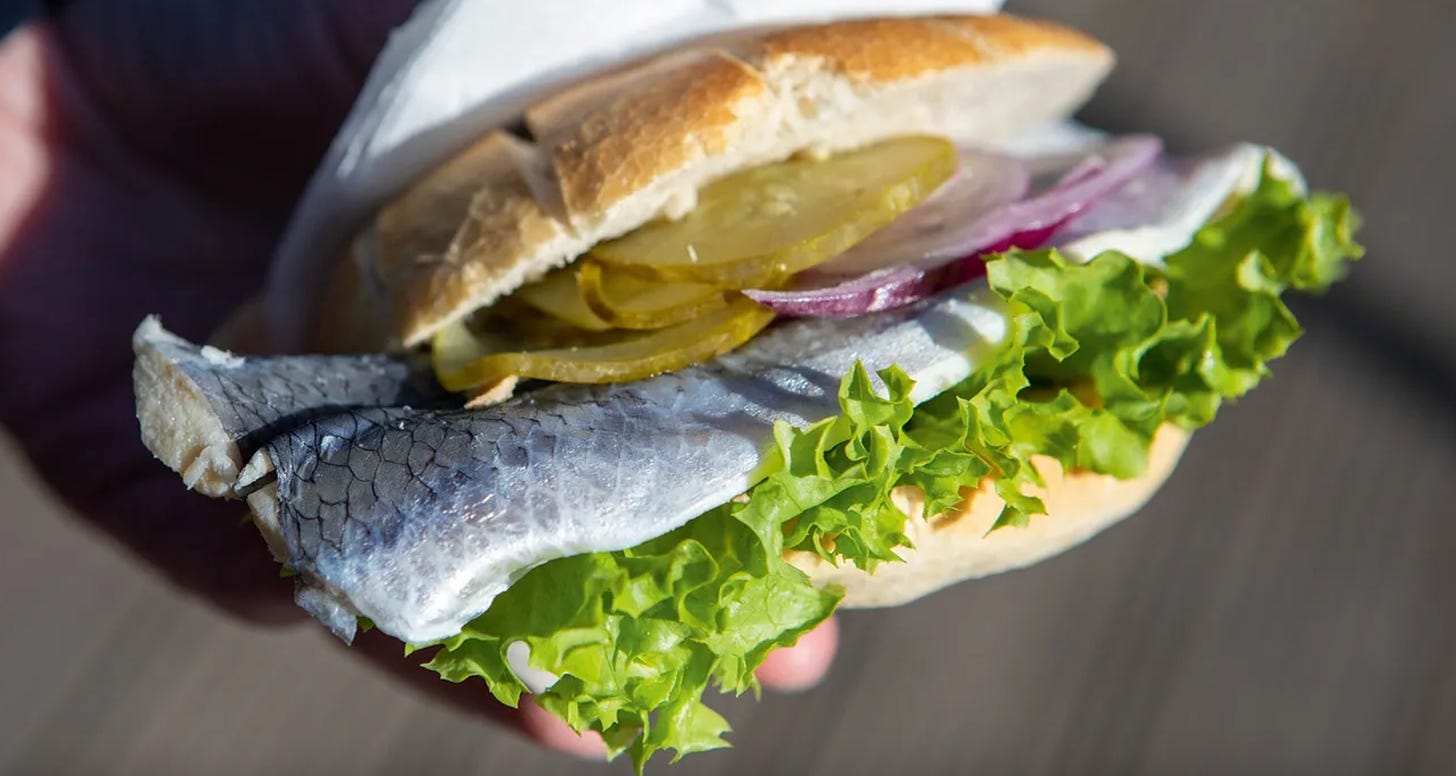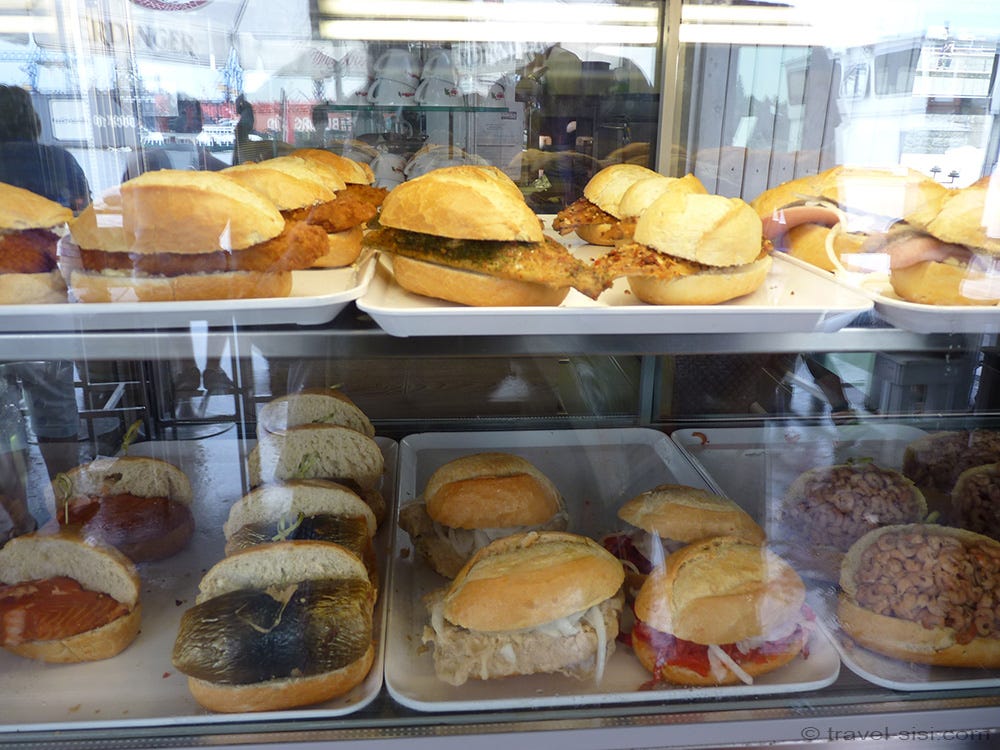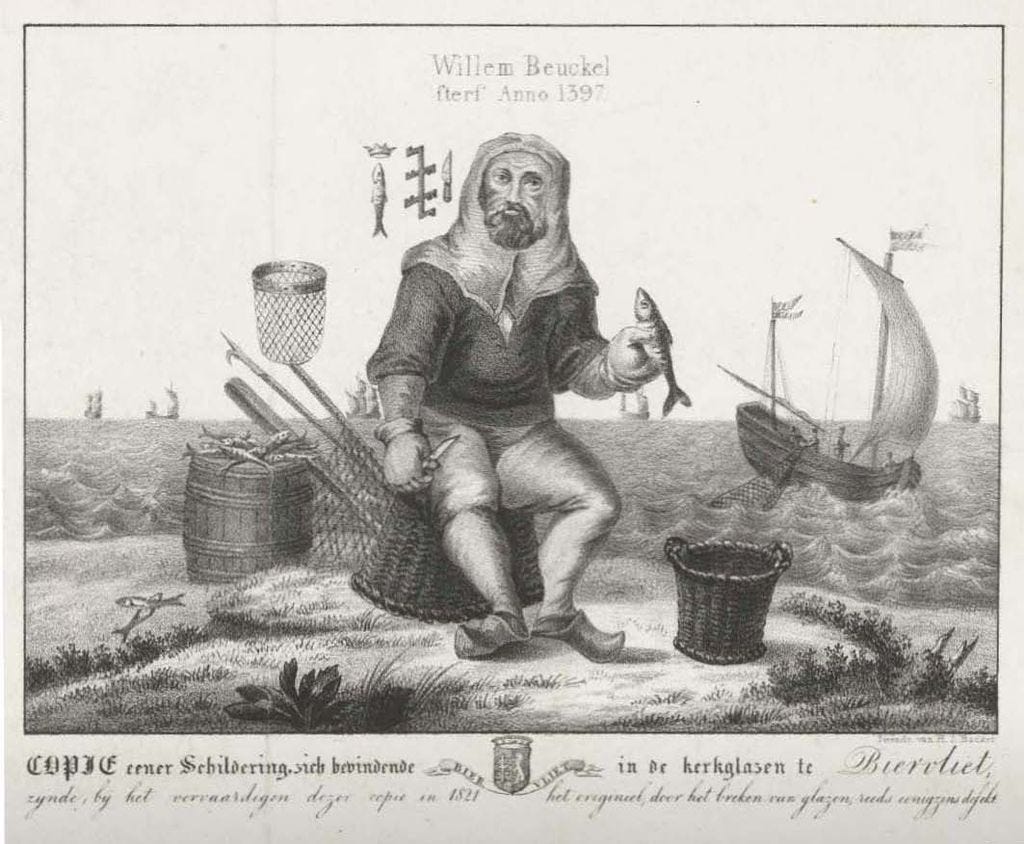Notable Sandwich #64: Fischbrötchen
In the land of hamburgers, the fish sandwich is king
Welcome to Notable Sandwiches, the series where Talia and I trip merrily through the ever-evolving document that is Wikipedia’s List of Notable Sandwiches in alphabetical order. This week, a northern German favorite: fischbrötchen
One evening in June, 2009, the late writer and neurologist Oliver Sacks arrived at the Roger Smith Hotel in midtown Manhattan to worship at the altar of one of his own personal deities: “Clupeus, the god of herring, whose annual festival is celebrated in late spring by herring-lovers the world over.” The herring, wrote Sacks in the New Yorker, has “played a great part in human history. In the Middle Ages, they were carefully graded and priced by the Hanseatic League, and supported fisheries in the Baltic and the North Sea.”
For the last millennium, the fate Northern Europe has ebbed and flowed with the teeming shoals of silvery herring, “one of the commonest, cheapest, and most delicious fish on the planet” as Sacks noted. “A fish that can take an infinity of forms: marinated, pickled, salted, fermented, smoked, or, as with the exquisite Hollandse Nieuwe, straight from the sea.”
That someone along the way would think to place this favored fish between two pieces of bread was inevitable, and today fischbrötchen—literally, “fish bread”—is as common in Northern Germany as bratwurst is in the south. And though the sandwich can be made with salmon or cod or shrimp or any other fish, herring is the preferred fisch in the region’s signature dish.
In the land of the hamburger, the fish sandwich is king. It was in Hamburg, allegedly, that an innovative 19th-century snack-bar proprietor took a few fillets, stuck them in a roll, and created the first fischbrötchen for the throngs of sailors, stevedores, and fishermen working along the city’s waterfront. In 2023, you won’t find any ground beef at Hamburg’s favorite sandwich spot. Instead, Brücke 10 serves a variety of fischbrötchen, including rollmops, salmon, crab, fried mackerel, herb matjes, and the signature, bismarck herring with onion on a crunchy white roll.
But, as Sacks noted, herring was a major engine for European empire-building long before it made its way into a sandwich. Nowhere is this better exemplified than the legendary visit, in 1556, of the Emperor Charles V to the Dutch town of Biervliet. In the 16th century, there was no more powerful ruler in Europe than Charles: Germany’s Holy Roman Emperor, Archduke of Austria, King of Spain, Duke of Burgundy, and Lord of the Netherlands. Charles didn’t come to Biervliet to break bread with a local potentate, but to kneel before the tomb of Willem Beukel, and pay tribute to this humble Medieval fisherman and his enduring legacy: the pickled herring.
“Were I a Dutchman I would depose the regal and rampant lion emblazoned on the arms of the Netherlands and enthrone in its stead a couple of crossed herrings, each with a golden ten-guilder piece in its mouth,” proclaimed Charles. “I would place it on a field formed by a herring net. And I would be at least as proud of it as your Dutchman is of his ‘Netherlands Lion Rampant.’”
I’ll be honest: until this week’s column, I had never given much thought to the herring industry, and had never even heard of fischbrötchen—this despite the sandwich’s ubiquity in Germany (and the ubiquity of German food in my childhood.) Which is not to say that I’m unfamiliar with the concept. I grew up in Manhattan, after all, and what’s lox on a bagel if not the New York version of fischbrötchen?
Given that so many Jewish immigrants came from Germany, it’s no surprise that they would have brought the cuisine of the Baltic to New York. At Shelsky’s in Brooklyn, my local delicatessen, you can get your bagel with dozens of varieties of salmon, whitefish, smoked trout, sable, shrimp, sturgeon, mackerel, lobster, tuna, and six kinds of herring. I fell in love with Shelsky’s house-pickled herring earlier this spring, while researching Notable Sandwich #61, the dyrlægens natmad. These are all technically fish sandwiches, ie. fischbrötchen.
New York took a long time to regard its own natural bounty as the top-notch cuisine it truly is. The city was once a hotbed of herring, according to Russell Jacobs at Hellgate NYC. “Well into the 20th century, New York had huge runs of river herring—blueback herring, alewives, hickory shad, and American shad, all of which swarmed up the Hudson to spawn each spring. During the winter, Atlantic herring would pour into the city’s estuaries, congregating in enormous ‘herring shoals.’ For a while, New Yorkers caught these fish to the order of millions of pounds per year, creating steady work for the city’s 15 curing houses, which smoked, pickled, brined, salted, and otherwise preserved everything that wasn’t sold fresh, made into fertilizer, or used as bait.”
The Sword and the Sandwich is a newsletter about serious extremism and equally serious sandwiches. Please consider supporting this work with a paid subscription:
Oliver Sacks’s British childhood was similarly herring-laden. “When I grew up in England, in the nineteen-thirties, we had herring virtually every day: smoked herring (kippers or bloaters) at breakfast, perhaps a herring pie at lunch (my mother’s favorite dish), fried herring roe on toast at teatime, chopped herring at dinner,” he reflected. “But times have changed, herring is no longer on every breakfast and dinner table, and it is only on special, joyous occasions that we clupeophiles can come together for a real herring feast.”
Next week, New York’s clupeophiles will once again be gathering for just such an occasion. At 12pm next Wednesday, the Oyster Bar at Grand Central Terminal is hosting the 38th Annual Holland Herring Festival, the same event Sacks attended in 2009. From June 13 through the 29th, diners can sample the “first Holland herring of the season.” But if you’re tastes run more Deutsch than Dutch, and you’re craving fischbrötchen, just pocket a few fillets and make yourself one at home. Turn your table into an altar to Clupeus the herring god, give a toast to Willem Beukel, and enjoy a meal fit for an emperor.









Mmm, now I'm missing kippers on toast which used to be a favorite breakfast of mine back in England...! Reading your sandwich episodes nearly always makes me me hungry -- I should know better than read them close to bedtime.
I went to visit a friend in Stockholm many years ago and he took me to a restaurant that specialized in two things: herring and reindeer -- I was in heaven! So many different preparations of herring.
(and the reindeer was good too)
It's taken on a new role (roll?) here in London recently; the Fish Finger (Fish sticks, in US parlance) sandwich is now often seen in high end restaurants. Had one last week at Ochre and I noticed that there is also one on the menu at the revived Manzi's, scheduled to open towards the end of the month. Its previous role was as the British toddler's favourite dinner.